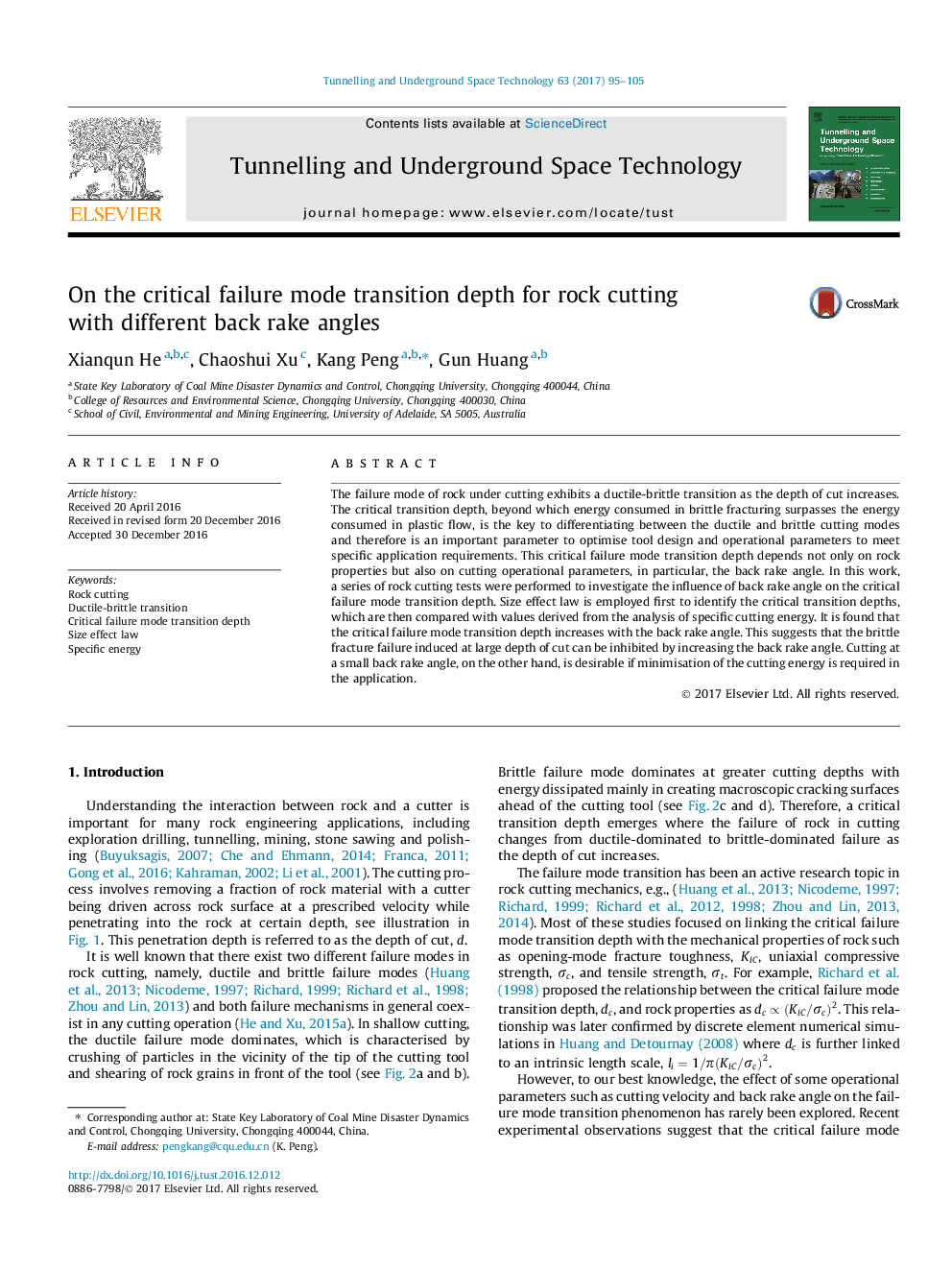| کد مقاله | کد نشریه | سال انتشار | مقاله انگلیسی | نسخه تمام متن |
|---|---|---|---|---|
| 4929375 | 1432283 | 2017 | 11 صفحه PDF | دانلود رایگان |
عنوان انگلیسی مقاله ISI
On the critical failure mode transition depth for rock cutting with different back rake angles
ترجمه فارسی عنوان
در حالت شکست بحرانی عمق انتقال برای سنگ برش با زاویه عقب مختلف عقب
دانلود مقاله + سفارش ترجمه
دانلود مقاله ISI انگلیسی
رایگان برای ایرانیان
کلمات کلیدی
برش سنگ، انتقال پوسچر و شکننده، عمق شکست انتقالی بحرانی، قانون اثر بزرگ، انرژی خاص
ترجمه چکیده
حالت شکست سنگ زیر برش نشان می دهد انتقال گذار ورقه ای به عنوان عمق برش افزایش می یابد. عمق انتقال انتقادی، فراتر از آن که انرژی مصرف شده در شکستگی شکننده، انرژی مصرف شده در جریان پلاستیکی را فراتر می برد، کلید جداسازی بین روش های برش مجلسی و شکننده می باشد و از این رو یک پارامتر مهم برای بهینه سازی طراحی ابزار و پارامترهای عملیاتی برای رفع نیازهای خاص برنامه . این عمق انتقال بحران حالت بحرانی نه تنها به خواص سنگ بستگی دارد بلکه بر برش پارامترهای عملیاتی، به ویژه، زاویه عقب عقب است. در این کار، یک سری از آزمایش های برش سنگ برای بررسی تاثیر زاویه عقب عقب بر روی حالت انتقال انتقادی حالت بحرانی انجام شد. قانون اثر اندازه برای اولین بار برای شناسایی عمق انتقادی انتقالی، که سپس با مقادیر حاصل از تجزیه و تحلیل انرژی برش خاصی مقایسه می شود، استفاده می شود. مشخص شده است که عمق انتقال بحران حالت بحرانی با زاویه عقب عقب افزایش می یابد. این نشان می دهد که شکستگی شکننده شکننده در عمق زیاد برش می تواند با افزایش زاویه عقب عقب مانده باشد. از سوی دیگر، برش در یک زاویه عقب کوچک، مطلوب است، اگر حداقل در انرژی مورد نیاز برش در برنامه کاربردی باشد.
موضوعات مرتبط
مهندسی و علوم پایه
علوم زمین و سیارات
مهندسی ژئوتکنیک و زمین شناسی مهندسی
چکیده انگلیسی
The failure mode of rock under cutting exhibits a ductile-brittle transition as the depth of cut increases. The critical transition depth, beyond which energy consumed in brittle fracturing surpasses the energy consumed in plastic flow, is the key to differentiating between the ductile and brittle cutting modes and therefore is an important parameter to optimise tool design and operational parameters to meet specific application requirements. This critical failure mode transition depth depends not only on rock properties but also on cutting operational parameters, in particular, the back rake angle. In this work, a series of rock cutting tests were performed to investigate the influence of back rake angle on the critical failure mode transition depth. Size effect law is employed first to identify the critical transition depths, which are then compared with values derived from the analysis of specific cutting energy. It is found that the critical failure mode transition depth increases with the back rake angle. This suggests that the brittle fracture failure induced at large depth of cut can be inhibited by increasing the back rake angle. Cutting at a small back rake angle, on the other hand, is desirable if minimisation of the cutting energy is required in the application.
ناشر
Database: Elsevier - ScienceDirect (ساینس دایرکت)
Journal: Tunnelling and Underground Space Technology - Volume 63, March 2017, Pages 95-105
Journal: Tunnelling and Underground Space Technology - Volume 63, March 2017, Pages 95-105
نویسندگان
Xianqun He, Chaoshui Xu, Kang Peng, Gun Huang,
